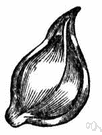achene
Also found in: Thesaurus, Medical, Encyclopedia, Wikipedia.
a·chene
also a·kene (ā-kēn′)n.
A small, dry, indehiscent one-seeded fruit with a thin wall, as in a sunflower.
[New Latin achēnium : Greek a-, without; see a-1 + Greek khainein, to yawn.]
a·che′ni·al (-nē-əl) adj.
American Heritage® Dictionary of the English Language, Fifth Edition. Copyright © 2016 by Houghton Mifflin Harcourt Publishing Company. Published by Houghton Mifflin Harcourt Publishing Company. All rights reserved.
achene
(əˈkiːn) orakene
n
(Botany) a dry one-seeded indehiscent fruit with the seed distinct from the fruit wall. It may be smooth, as in the buttercup, or feathery, as in clematis. Also called: achenium
[C19: from New Latin achaenium that which does not yawn or open, from a-1 + Greek khainein to yawn]
aˈchenial, aˈkenial adj
Collins English Dictionary – Complete and Unabridged, 12th Edition 2014 © HarperCollins Publishers 1991, 1994, 1998, 2000, 2003, 2006, 2007, 2009, 2011, 2014
a•chene
(eɪˈkin, əˈkin)n.
any small, dry, hard, one-seeded, indehiscent fruit.
a•che′ni•al, adj.
Random House Kernerman Webster's College Dictionary, © 2010 K Dictionaries Ltd. Copyright 2005, 1997, 1991 by Random House, Inc. All rights reserved.
ThesaurusAntonymsRelated WordsSynonymsLegend:
Switch to new thesaurus
| Noun | 1. |  achene - small dry indehiscent fruit with the seed distinct from the fruit wall achene - small dry indehiscent fruit with the seed distinct from the fruit wallfruit - the ripened reproductive body of a seed plant |
Based on WordNet 3.0, Farlex clipart collection. © 2003-2012 Princeton University, Farlex Inc.